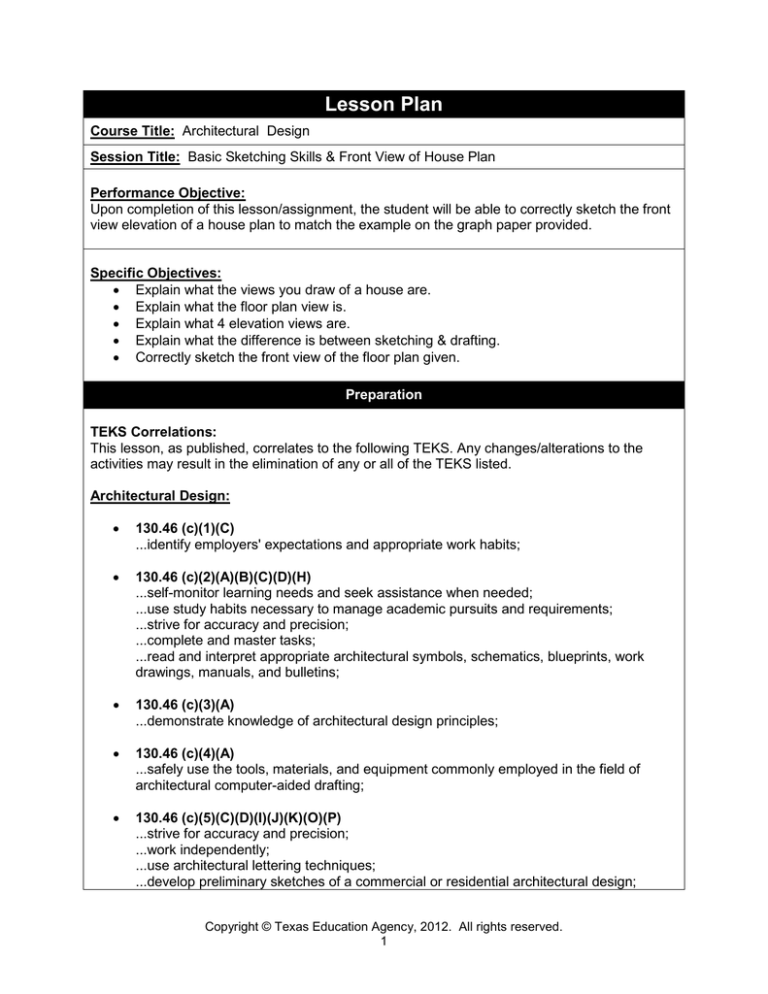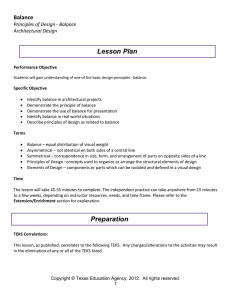Lesson Plan
advertisement

Lesson Plan Course Title: Architectural Design Session Title: Basic Sketching Skills & Front View of House Plan Performance Objective: Upon completion of this lesson/assignment, the student will be able to correctly sketch the front view elevation of a house plan to match the example on the graph paper provided. Specific Objectives: • Explain what the views you draw of a house are. • Explain what the floor plan view is. • Explain what 4 elevation views are. • Explain what the difference is between sketching & drafting. • Correctly sketch the front view of the floor plan given. Preparation TEKS Correlations: This lesson, as published, correlates to the following TEKS. Any changes/alterations to the activities may result in the elimination of any or all of the TEKS listed. Architectural Design: • 130.46 (c)(1)(C) ...identify employers' expectations and appropriate work habits; • 130.46 (c)(2)(A)(B)(C)(D)(H) ...self-monitor learning needs and seek assistance when needed; ...use study habits necessary to manage academic pursuits and requirements; ...strive for accuracy and precision; ...complete and master tasks; ...read and interpret appropriate architectural symbols, schematics, blueprints, work drawings, manuals, and bulletins; • 130.46 (c)(3)(A) ...demonstrate knowledge of architectural design principles; • 130.46 (c)(4)(A) ...safely use the tools, materials, and equipment commonly employed in the field of architectural computer-aided drafting; • 130.46 (c)(5)(C)(D)(I)(J)(K)(O)(P) ...strive for accuracy and precision; ...work independently; ...use architectural lettering techniques; ...develop preliminary sketches of a commercial or residential architectural design; Copyright © Texas Education Agency, 2012. All rights reserved. 1 ...use traditional technical architectural drafting techniques to create drawings; ...draw schematic site plans, floor plans, building elevations, sections, perspectives, and character sketches from bubble diagrams; ...draw scaled wall thickness plans, elevations, and sections; • 130.46 (c)(7)(A)(B) ...begin illustrating ideas for architectural projects from direct observation, experiences, and imagination; and ...begin comparing and contrasting the use of architectural elements such as color, texture, form, line, space, value, and architectural principles such as emphasis, pattern, rhythm, balance, proportion, and unity in personal architectural projects and those of others using vocabulary accurately. • 130.46 (c)(8)(A)(B)(C) ...create beginning visual solutions by elaborating on direct observation, experiences, and imagination; ...create beginning designs for practical applications; and ...demonstrate beginning effective use of architectural media and tools in design, drawing, painting, printmaking, and sculpture such as model building. • 130.46 (c)(10)(A) ...interpret, evaluate, and justify architectural artistic decisions in personal architectural projects; • 130.46 (c)(12)(B) ...use mathematical equations; Interdisciplinary Correlations: English: • 110.44 (b)(6)(B)(E) …rely on context to determine meanings of words and phrases such as figurative language, connotation and denotation of words, analogies, idioms, and technical vocabulary; …use reference material such as glossary, dictionary, thesaurus, and available technology to determine precise meanings and usage; Geometry: • 111.34 (b)(4) …select an appropriate representation (concrete, pictorial, graphical, verbal, or symbolic) in order to solve problems; • 111.34 (b)(5)(A)(B)(C)(D) …use numeric and geometric patterns to develop algebraic expressions representing geometric properties; …use numeric and geometric patterns to make generalizations about geometric properties, including properties of polygons, ratios in similar figures and solids, and Copyright © Texas Education Agency, 2012. All rights reserved. 2 angle relationships in polygons and circles; …use properties of transformations and their compositions to make connections between mathematics and the real world, such as tessellations; …identify and apply patterns from right triangles to solve meaningful problems, including special right triangles (45-45-90 and 30-60-90) and triangles whose sides are Pythagorean triples. • 111.34 (b)(6)(C) …use orthographic and isometric views of three-dimensional geometric figures to represent and construct three-dimensional geometric figures and solve problems; • 111.34 (b)(11)(A) …use and extend similarity properties and transformations to explore and justify conjectures about geometric figures. Mathematical Models with Applications: • 111.36(c) (1)(A)(B)(C) …compare and analyze various models for solving a real-life problem; …use multiple approaches (algebraic, graphical, and geometric methods) to solve problems from a variety of disciplines; …select a method to solve a problem, defend the method, and justify the reasonableness of the results. Teacher Preparation: Read through the PowerPoint provided and practice drawing the problem. Recommend the teacher draw this for the students on an overhead, or use a device like an elmo & show it on data projector screen. References: Texas approved publishers are: Goodheart-Willcox Delmar Learning Prentice Hall All have a companion workbook with more problems. Recommend using one of these or any other approved textbook; for example if you are ATC or TechPrep and must teach using local college textbook. Also, “Google” and you can find tons of information on these subjects! Instructional Aids: 1. Introduction to Front View PowerPoint presentation 2. Front View graph paper 3. Front View Elevation – 8’ 4. Front View Elevation – 10’ Materials Needed: 1. One (1) sheet of Front View graph paper for each student Copyright © Texas Education Agency, 2012. All rights reserved. 3 2. One (1) pencil & eraser for each student 3. Handout – Review questions Equipment Needed: 1. Data projector for PowerPoint. 2. Class set of hard copies of PowerPoint for students to use. 3. Overhead projector, transparency of Front View graph paper, & overhead pen(s) OR an elmo like device to demonstrate how to draw the problem. Learner preparation: The lesson is written on the assumption that students have taken engineering graphics, and that they already know basic sketching & drafting skills. If they have not, the teacher needs to go over these skills prior to the lesson. This is the first introduction to what house plans look like & why. Introduction Introduction (LSI Quadrant I): SAY: Today we will be sketching the front view of a house. SAY: We are ONLY sketching today, which means no tools used! Only your hand & a pencil. SAY & SHOW: The floor plan is the top view or what it looks like from the sky. SAY & SHOW: The front view has the most detail and is usually the side with the entrance door. SAY & SHOW: The other views line up as expected and off of the front view, back, right, & left sides. SAY & SHOW: Note that the views will always line up with the floor plan’s walls, windows, etc…. SHOW: The 10’ front view elevation without details. SHOW: The 10’ front view elevation with details. ASK: Which do you think is more realistic looking? ASK: Which one is easier to draw? SAY: Now we will sketch the front view of the house based on the examples given and a demonstration by me. Outline Outline (LSI Quadrant II): Instructors can use the PowerPoint presentation, slides, handouts, and note pages in conjunction with the following outline. MI Outline Notes to Instructor I. Explain what the views you draw of a house are. This doesn’t make sense to students unless you show them the views as they go together. Copyright © Texas Education Agency, 2012. All rights reserved. 4 . II. Explain what the floor plan view is. Ask students to pretend they are in a helicopter and looking down on their house. What would they see if there was no roof? That’s the floor plan. III. Explain what 4 elevation views are. Ask students why they think we draw all 4 views and not just 3 views like in multiviews? (Because they are different.) IV. Explain the differences between sketching and drafting. Stress again that sketching is just hand and pencil! This is not drafting. You don’t expect perfect straight lines you just do the best that you can. V. Correctly sketch the front view of the floor plan given. Students really need to watch the teacher do this so they have an idea of how to do it. Copy and paste Multiple Intelligences Graphic in appropriate place in left column. Verbal Linguistic Logical Mathematical Visual Spatial Musical Rhythmic Bodily Kinesthetic Intrapersonal Interpersonal Naturalist Existentialist Application Guided Practice (LSI Quadrant III): The teacher must explain the PowerPoint as they go through the lesson. Do NOT just read it or merely let students read it. Explain and give personal examples as you go. When students Copyright © Texas Education Agency, 2012. All rights reserved. 5 start drawing, make sure you monitor to ensure they are doing the work. Independent Practice (LSI Quadrant III): Draw the front view of the house based on the example given on the graph paper provided. Summary Review (LSI Quadrants I and IV): Q: Which view looks like what you see from the sky? A: Floor plan Q: Which view has the entrance door? A: Front Q: Why do we draw all 4 views and not just 3, as in a multiview? A: Because they are all different and show different things. Q: Do all the views need to line up with something on the floor plan? A: Yes, for example, windows and doors have to line up with each other. Q: What’s the big difference between the 10’ and 8’ front views given? A: Walls are taller; 7’ windows have arcs at the top. Q: Which one is harder to draw and why? A: The 10’ because of the arced windows Evaluation Informal Assessment (LSI Quadrant III): Walk around the room and monitor students as they work on the drawings. Correct, or redirect, mistakes before they get too bad. If they do get too bad, just give student a new piece of paper and have them try again. Formal Assessment (LSI Quadrant III, IV): Does it match the example given? Use the built in rubric and have students grade themselves first. Extension Extension/Enrichment (LSI Quadrant IV): 1. Allow students to pick which one they want to draw, 10’ or 8’; or, challenge them to do the harder one. Offer bonus points to add details like the roof shingles and/or bricks. 2. Tomorrow - have students draft the same view and this time be very picky on straight lines and arcs; but, be forewarned that drafting the same view can take up to 2 days. Copyright © Texas Education Agency, 2012. All rights reserved. 6 Basic Sketching Skills & Front View of House Plan Review Questions 1. Which view looks like what you see from the sky? 2. Which view has the entrance door? 3. Why do we draw all 4 views and not just 3, as in a multiview? 4. Do all the views need to line up with something on the floor plan? 5. What’s the big difference between the 10’ and 8’ front views given? 6. Which one is harder to draw and why? Copyright © Texas Education Agency, 2012. All rights reserved. 7 Basic Sketching Skills & Front View of House Plan Review Questions and Answers 1. Which view looks like what you see from the sky? Answer: Floor plan 2. Which view has the entrance door? Answer: Front 3. Why do we draw all 4 views and not just 3, as in a multiview? Answer: Because they are all different and show different things. 4. Do all the views need to line up with something on the floor plan? Answer: Yes, for example, windows and doors have to line up with each other. 5. What’s the big difference between the 10’ and 8’ front views given? Answer: Walls are taller, 7’ windows have arcs at the top. 6. Which one is harder to draw and why? Answer: The 10’ because of the arced windows. Copyright © Texas Education Agency, 2012. All rights reserved. 8 Copyright © Texas Education Agency, 2012. All rights reserved. 10

